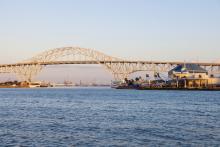A total of US$5.5 billion has been allocated for bridges repair under a new bill introduced by democratic transport leaders led by Nick J Rahall. To date, there are over 150,000 structurally deficient or functionally obsolete bridges across the US, according to the US Department of Transportation. Figures showed that a quarter of bridges in the country fall into one of the two categories, with 26.7%, 27.7% and 77.4% of bridges in Virginia, Maryland and Washington falling under one of the two categories resp
A total of US$5.5 billion has been allocated for bridges repair under a new bill introduced by democratic transport leaders led by Nick J Rahall. To date, there are over 150,000 structurally deficient or functionally obsolete bridges across the US, according to the 2364 US Department of Transportation.
Figures showed that a quarter of bridges in the country fall into one of the two categories, with 26.7%, 27.7% and 77.4% of bridges in Virginia, Maryland and Washington falling under one of the two categories respectively. In upgrading and strengthening bridges, total funding of over $337 million will be given to both Virginia and Maryland under Rahall's bill. The need to repair structure of the bridges was indicated by the recent collapse of the Interstate 5 bridge in Washington state.
There is concern that the new bill may fall victim to political infighting in the US, forsaking the wider long term economic benefits linked to high quality bridge infrastructure.
Figures showed that a quarter of bridges in the country fall into one of the two categories, with 26.7%, 27.7% and 77.4% of bridges in Virginia, Maryland and Washington falling under one of the two categories respectively. In upgrading and strengthening bridges, total funding of over $337 million will be given to both Virginia and Maryland under Rahall's bill. The need to repair structure of the bridges was indicated by the recent collapse of the Interstate 5 bridge in Washington state.
There is concern that the new bill may fall victim to political infighting in the US, forsaking the wider long term economic benefits linked to high quality bridge infrastructure.





